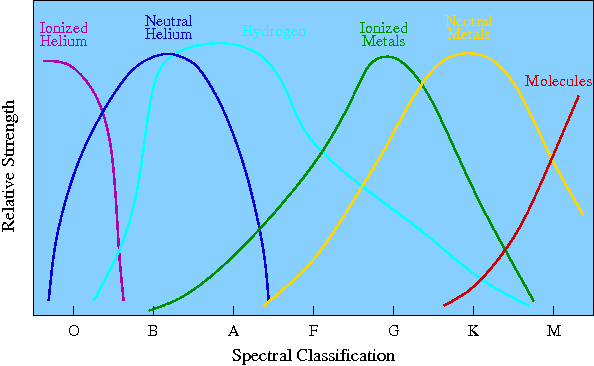 |
| [NMSU, N. Vogt] |
We can use spectral types to assign surface temperatures for stars. Once it was recognized that differences in spectral type (differences in the lines and line intensities found in spectra) were due mostly to differences in temperatures of the stars, the spectral sequence was reordered by temperature. Here we can see the relationship between stellar type and the elements that create each type of spectrum. A dominant characteristic of spectral class A stars is the presence of strong hydrogen lines, but ionized helium lines are only present in the class O stars. Since helium ionizes only at high temperatures, this tells us that class O stars must have very high surface temperatures. On the other hand, spectral lines associated with molecules are only found for spectral classes K and M. This is because these correspond to low surface temperatures, and molecules can only hold together in stars with relatively low surface temperatures.
 |
| [NMSU, N. Vogt] |
This table conveys the same information as the diagram, showing the relationship between spectral type and the different elements. The last two columns indicate the temperatures found in the atmospheres of these type of stars, and some representative candidates. What type of star is our Sun?
| Spectral Classification Sequence | |||
|---|---|---|---|
| Class | Distinguishing Characteristics | Temperature (K) | Examples |
| O | Ionized helium and metals, weak hydrogen | 28,000 – 60,000 | zeta Orionis |
| B | Neutral helium, ionized metals, stronger hydrogen | 10,000 – 28,000 | Rigel, Spica |
| A | Hydrogen dominant, singly-ionized metals | 7500 – 10,000 | Sirius, Deneb |
| F | Hydrogen weaker, neutral and singly-ionized metals | 6000 – 7500 | Procyon, Canopus |
| G | Singly ionized calcium, hydrogen weaker, neutral metals | 5000 – 6000 | Sun, Capella |
| K | Neutral metals, molecular bands begin to appear | 3500 – 5000 | Aldebaran, Arcturus |
| M | Titanium oxide molecular lines, neutral metals | < 3500 | Antares, Betelgeuse |